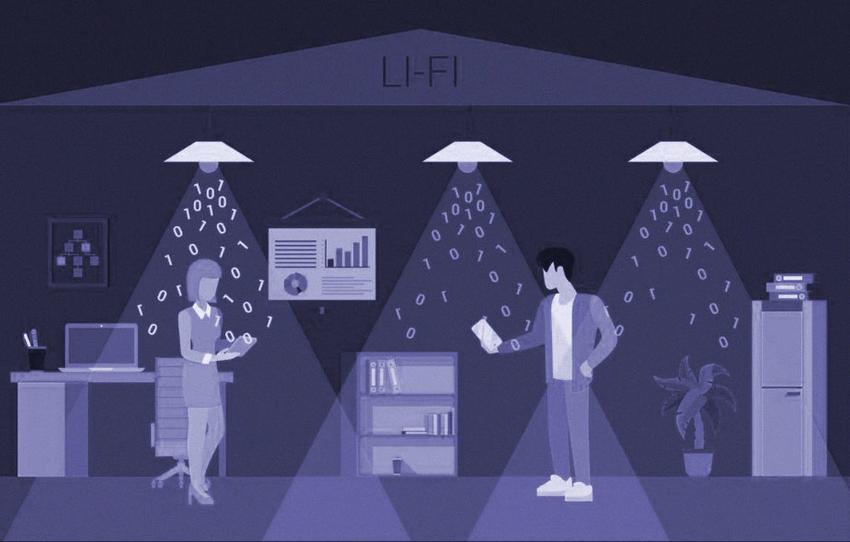- Li-Fi, or Light Fidelity, is a new wireless communication standard.
- Li-Fi provides speed up to 100 times faster than Wi-Fi. It has already found its application in the enterprises.
- Just a led lamp can be used for connecting devices.
- It has pros and cons, like short range and interference from sunlight.
The introduction of the Wi-Fi wireless standard in 1997 is widely recognized as a significant technological accomplishment of the late 20th and early 21st centuries. However, the idea of wireless communication is not a new concept. In reality, Wi-Fi utilizes the same radio communication technology that was discovered in the late 19th century, which is based on electromagnetic radiation. The primary distinction between Wi-Fi and traditional radio communication is the wavelength.
Wi-Fi waves are much shorter, which makes Wi-Fi capable of transmitting more information per unit of time.
If so, why not use even shorter wavelengths of electromagnetic radiation, such as visible light, to transmit data? Is it possible?
Yes, this technology exists, moreover, its standard was officially approved by the non-profit organization IEEE – Institute of Electrical and Electronics Engineers in June 2023 . The new technology is called Li-Fi , or Light Fidelity.

A Brief History of Li-Fi
The idea to use visible light to exchange information belongs to a physicist, professor at the University of Edinburgh Harald Haas. He defined the term “Li-Fi” in 2011 . The first experiments conducted by the professor in the laboratories of the Estonian company Velmenni brought not only success, but also opened up prospects for the commercialization of the technology.
The first public demonstration of Li-Fi aroused interest, although there were many skeptics who argued that the concept proposed by Haas was too complicated to implement. Despite initial skepticism, the professor proved his critics wrong by unveiling a small yet effective model of the “light” router just four years later.
The result of the latter’s work turned out to be truly excellent. Compared to Wi-Fi , the Li-Fi standard produced record speeds – 224 Gb / s, which is at least 100 times faster than Wi-Fi.
The basic principle of Li-Fi operation
Li-Fi technology is based on the use of electromagnetic radiation in the same way, the only difference is that instead of radio frequencies, Li-Fi uses visible light, which is converted by a silicon receiver into an electrical signal. The source of the signal is a household LED lamp with three standard color channels – red, green and blue, as well as a special chip that modulates light at a high frequency of 60Hz and higher.
Thanks to the latter, flicker becomes imperceptible to the human eye. Thus, LED lamps can be used both for lighting rooms and for high-speed Internet data transfer. In addition to the source and receiver of light, which can be either built-in or removable like a USB modem, a special controller-router is included in the set of Li-Fi devices .
Pros and cons of Li-Fi
Like any technology, Li-Fi has its advantages and disadvantages, and the latter can be quite significant.
Key Benefits
- High data transfer rate. In real conditions, the average speed is from
10 Gb/s. - Wider bandwidth.
- High level of security – the range of the signal is limited by the opaque walls of the room.
- Li-Fi does not interfere with radio signals.
Main disadvantages
- Works only in direct light conditions. In reflected light conditions, there is a significant decrease in speed.
- The working radius is only 10 meters .
- Sunlight can interfere with signal transmission.
- Li-Fi requires a separate infrastructure that is incompatible with current Wi-Fi standards .
The future for Li-Fi
The IT industry has seen many promising technologies fail to materialize. Will Li-Fi suffer the same fate? Market research firm Mordor Intelligence reports that it will not. In 2020, the Li-Fi market was valued at $295.4 million. Projections indicate that it will reach $4157.38 million by 2026, a clear indication of the increasing interest and demand for this innovative technology.
Today, a number of world-class companies already use Li-Fi. In particular Nav Wireless Technologies Pvt Ltd and Getac Technology adopted the technology back in 2020. Li-Fi can work well in smart homes, supermarkets, aircraft cabins, military facilities, transport networks and navigation systems, to provide communication during underwater work, and so on.
At the same time, it is clearly not worth expecting Wi-Fi to be replaced by the new Light Fidelity standard. Most likely, both standards will coexist or exist in combination with each other. Maybe one day engineers can overcome the shortcomings that limit the use of light technology for data transmission in different natural conditions.
